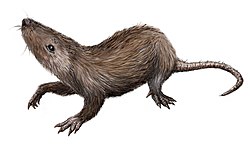Species
Five species have been described, but as of 2021 only the type species E. magnus is valid. [1]
Eobaatar magnus
This species was named by Kielan-Jaworowska Z., Dashzeveg D. and Trofimov B.A. in 1987. It is based on a fragment of lower jaw with teeth found in Aptian or Albian (Lower Cretaceous) strata of the Dzunbain Formation in Guchin Us County, Mongolia.
"Eobaatar" hispanicus
This species was named by Hahn G. and Hahn R. in 1992. Remains consisting of a single tooth were found in Hauterivian - Barremian (Lower Cretaceous)-age strata of the Camarillas Formation, Spain. In 2021 review, it is considered as an eobaatarid but certainly not member of genus Eobaatar. [1]
"Eobaatar" minor
This species was also named by Kielan-Jaworowska Z., Dashzeveg D. and Trofimov B.A. in 1987. Remains were found in Lower Cretaceous Dzunbain Formation of Mongolia. Going by the species name, it was probably relatively small. It got own genus Nokerbaatar in 2021. [1]
"Eobaatar" pajaronensis
This species was named by Hahn G. and Hahn R. in 2001. Remains were discovered in Barremian (Lower Cretaceous) strata of the Camarillas Formation in Spain. 2021 review considered that known remains are not diagnostic and attribution to this genus is not confirmed. [1]
"Eobaatar" clemensi
This species was named by Steven Sweetman in 2009. Remains were found in the Barremian (lower Cretaceous) of the Wessex formation, England. In 2021 review, it is considered as an eobaatarid but certainly not member of genus Eobaatar. [1]
This page is based on this
Wikipedia article Text is available under the
CC BY-SA 4.0 license; additional terms may apply.
Images, videos and audio are available under their respective licenses.

